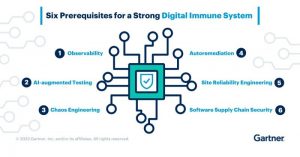 Digital immune systems (DIS) are a new approach to cybersecurity that is inspired by the human immune system. DIS are designed to be proactive, adaptive, and resilient, making them well-suited to address the challenges of the modern cyber threat landscape.
Digital immune systems (DIS) are a new approach to cybersecurity that is inspired by the human immune system. DIS are designed to be proactive, adaptive, and resilient, making them well-suited to address the challenges of the modern cyber threat landscape.
DIS use a variety of technologies, including artificial intelligence (AI), machine learning (ML), and big data analytics, to detect and respond to threats in real time. DIS can learn from past incidents and adapt to new threats as they emerge, making them more effective than traditional cybersecurity solutions.
DIS offer a number of advantages over traditional cybersecurity solutions, including:
- Proactiveness: DIS are designed to detect and respond to threats before they can cause damage. This is in contrast to traditional cybersecurity solutions, which are largely reactive and focus on containing threats after they have been detected.
- Adaptability: DIS can learn from past incidents and adapt to new threats as they emerge. This makes them more effective at defending against zero-day attacks and other sophisticated threats.
- Resilience: DIS are designed to be resilient to attacks. This means that even if an attack is successful, the DIS can continue to operate and protect the system.
DIS is still a relatively new technology, but it has the potential to revolutionize the way we approach cybersecurity. As DIS continue to develop and mature, they are expected to play an increasingly important role in protecting our digital infrastructure from cyber threats.
Here are some specific examples of how DIS can be used to improve cybersecurity:
- AI-powered threat detection: DIS can use AI to analyze large volumes of data from network traffic, security logs, and other sources to identify patterns and anomalies that may indicate a potential threat. This can help organizations to detect threats earlier and more accurately than traditional methods.
- Automated response: DIS can be configured to automatically respond to threats in a variety of ways, such as blocking malicious traffic, isolating infected devices, and quarantining infected files. This can help to mitigate the impact of an attack and prevent it from spreading.
- Self-healing: DIS can be designed to self-heal from attacks. This means that even if an attacker is able to damage a system, the DIS can automatically repair the damage and restore the system to its original state.
The future of DIS
The future of DIS is very bright. As AI and ML technologies continue to develop, DIS will become even more effective at detecting and responding to cyber threats. Additionally, DIS are expected to become more integrated with other security systems, such as firewalls and intrusion detection systems, to create a more comprehensive and layered security posture.
Overall, DIS have the potential to revolutionize the way we approach cybersecurity. By being proactive, adaptive, and resilient, DIS can help organizations to better protect themselves from the ever-evolving cyber threat landscape.